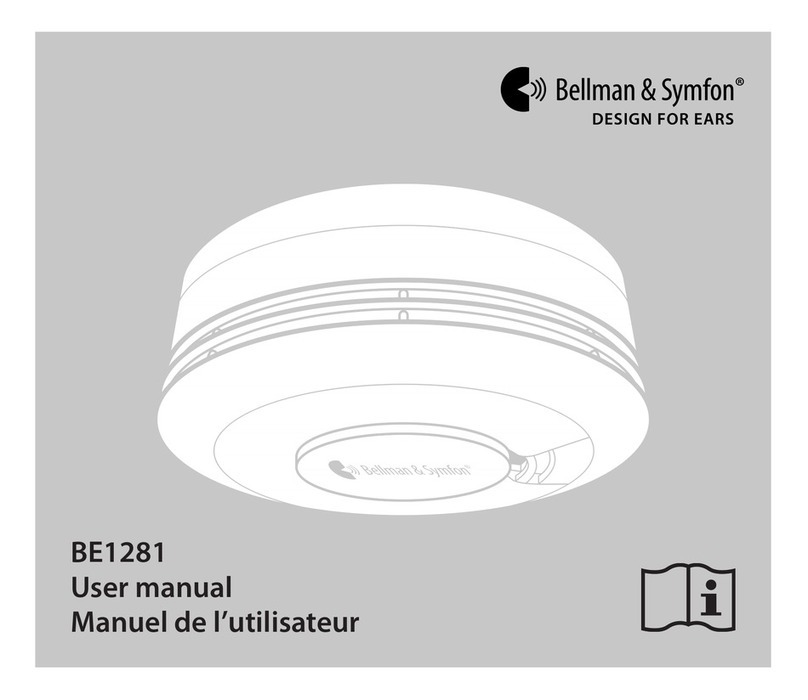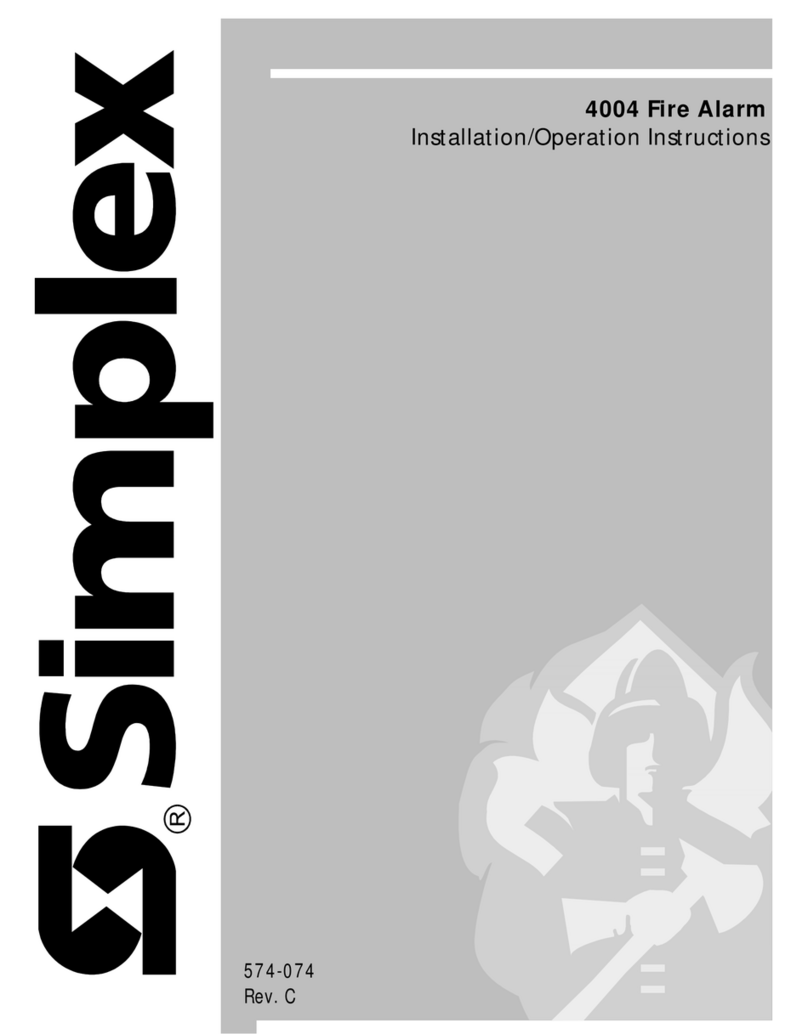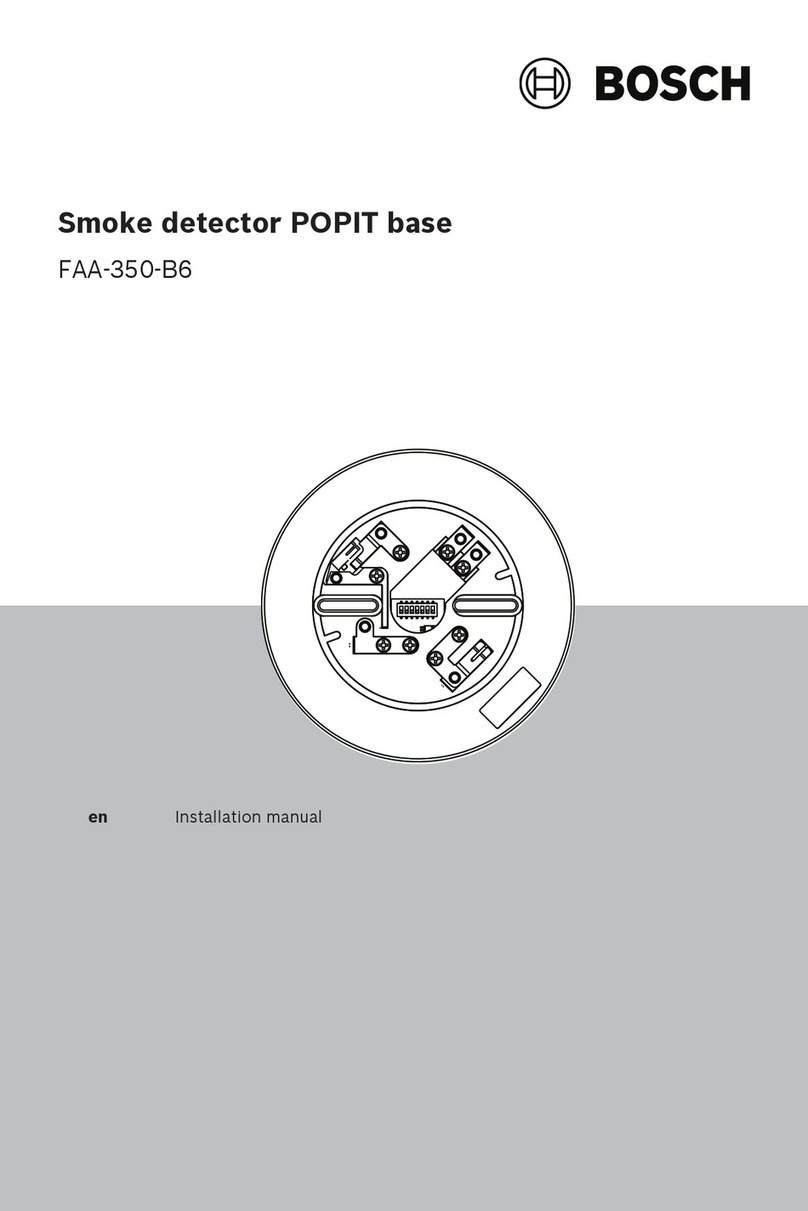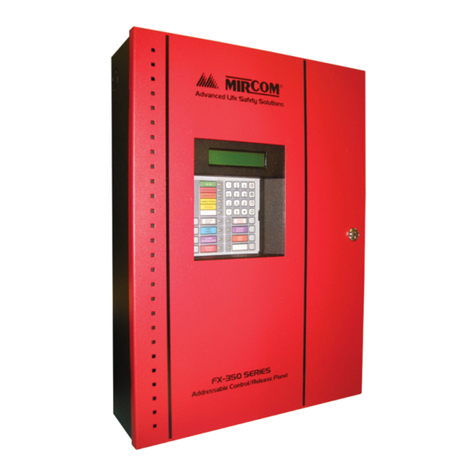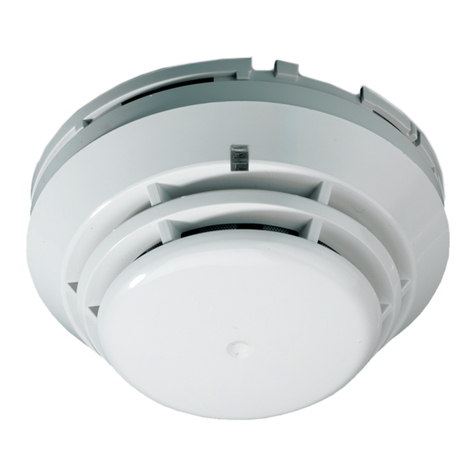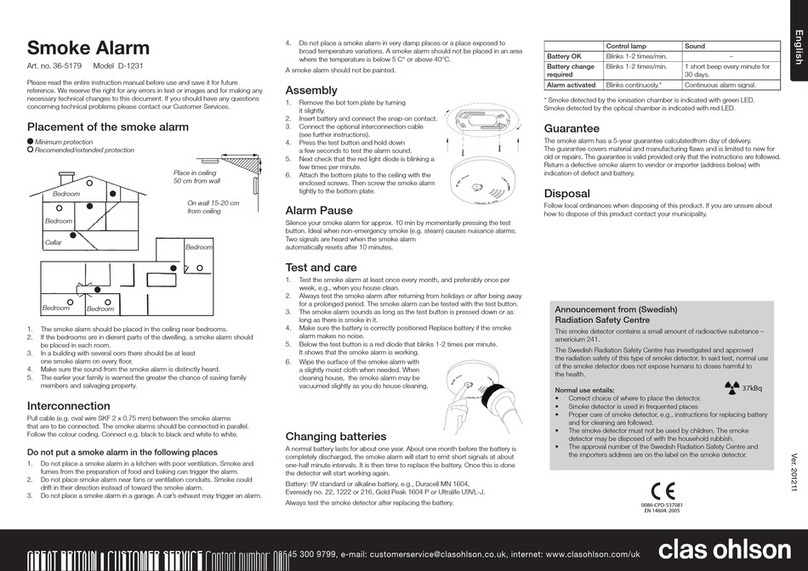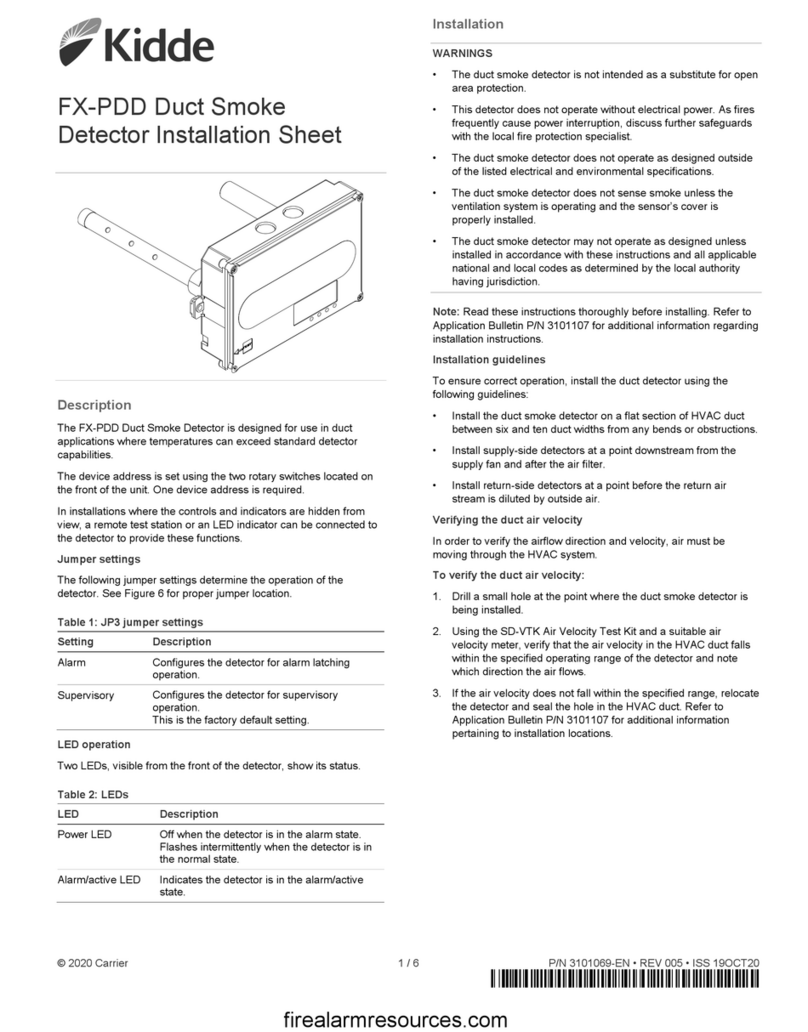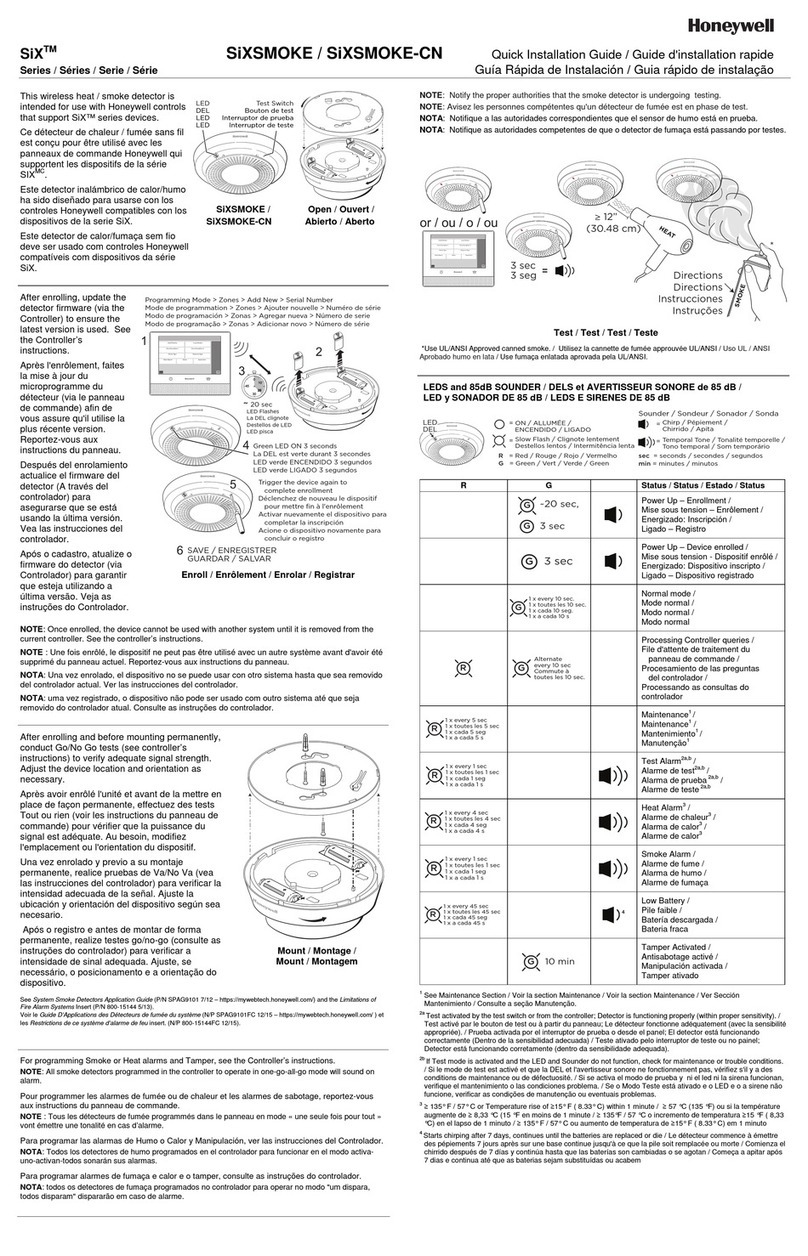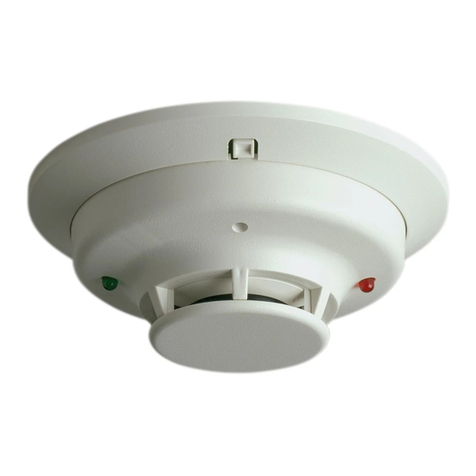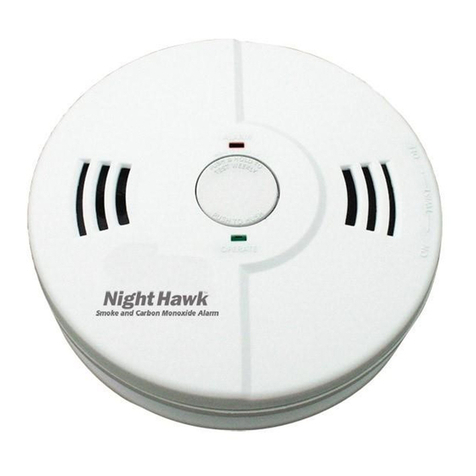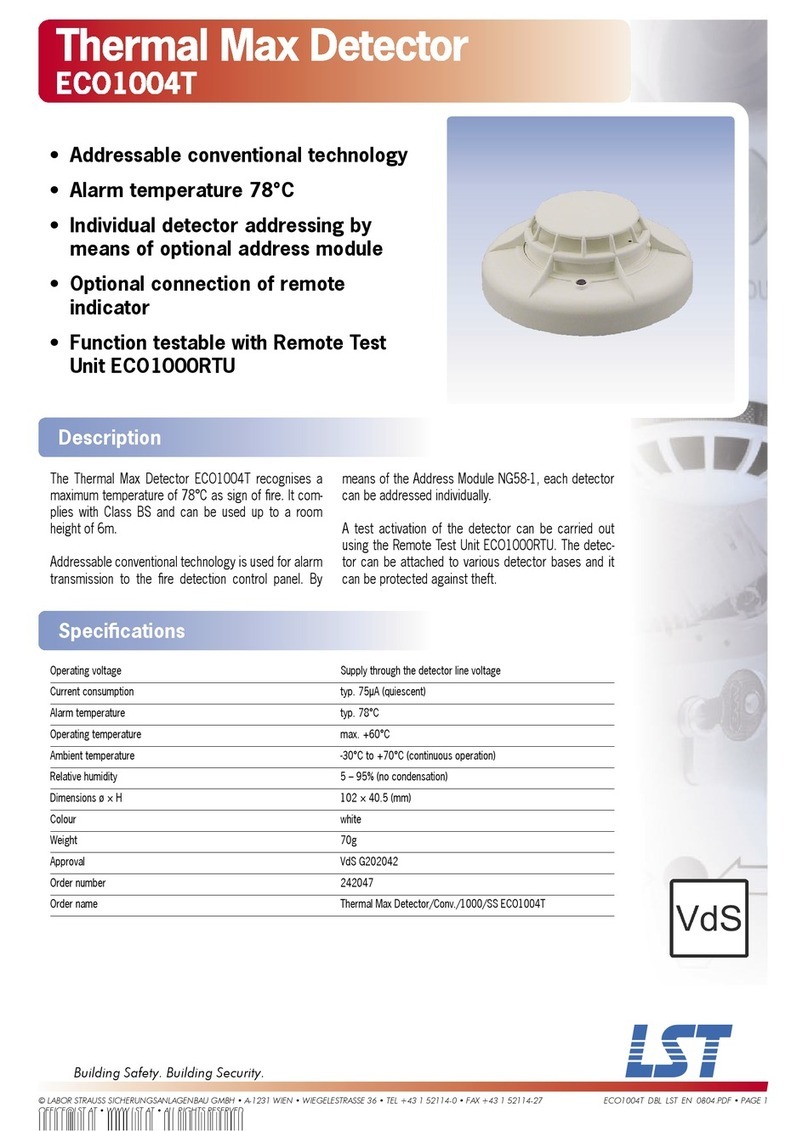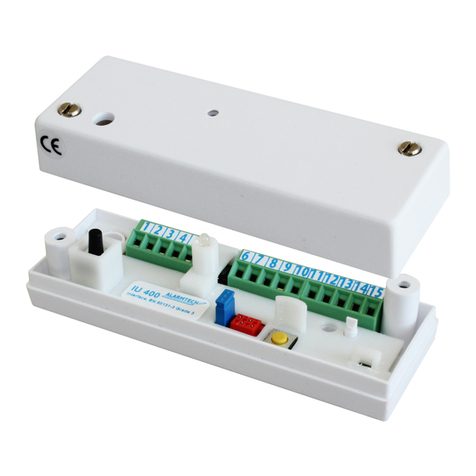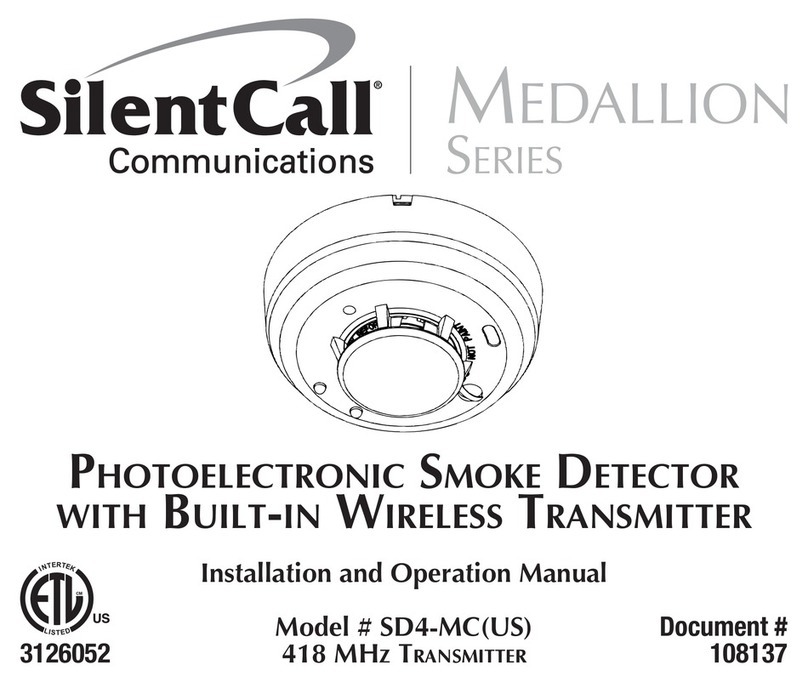Bellman & Symfon VISIT BE1551 User manual

BE1551 VISIT SMOKE ALARM

Medical device information 5
Installation 9
Signal pattern 10
Using broadcast 10
Changing the radio key 11
Location and positioning 13
Testing and maintenance 16
Fire safety advice 18
Alarm limitations 20
Troubleshooting 22
Technical specications 23
Service and support 24
Contents
43
Signal horn
Battery
Test button
Front cover Radio button
Radio LED
Status LED
Overview
EN

Read this rst
Thank you for choosing a product from Bellman & Symfon – the world leader in alerting
systems based in Gothenburg, Sweden. This user guide contains important medical device
information. Please read it carefully to make sure that you understand and get the best
out of your Bellman & Symfon product. If you are just installing the unit, the booklet must
be given to the householder. For more information about features and benets, contact
your hearing care professional.
About the BE1551 Visit smoke alarm
Intended purpose
This device is part of the Visit alerting system. The intended purpose of the system is to
alert deaf and hard of hearing people of important signals in their home. The smoke alarm
transmitter detects smoke and smoldering re at an early stage and sends a signal to the
Visit receiver that alerts the user with sound, ashes or vibrations.
Intended user group
The intended user group consists of people of all ages with mild to severe hearing loss or
deafness that need audio, visual or sensory amplication of smoke alarms.
Intended user
The intended user is a person with mild to severe hearing loss or deafness.
Principle of operation
The Visit alerting system consists of a set of wirelessly connected transmitters and receiv-
ers that are located across the home. When a transmitter detects an activity, it signals
the Visit receiver that alerts the user with sound, ashes or vibrations. In order to use the
system, you need at least one transmitter and one receiver.
A smoke alarm is an early warning device. Used correctly it can give you and your
family valuable extra time to escape. When the alarm sounds, immediately evacuate
the premises before beginning any investigation.
This device will not restore normal hearing and will not prevent or improve a hearing
impairment or deafness resulting from organic conditions.
This smoke alarm is equipped with a radio module that transmits radio signals to one
or several supplementary Visit receivers. A Visit receiver will help to ensure that the
alarm is noticed throughout the property. The alert and signal pattern for the Visit
receiver is explained in the product’s user manual.
Regulatory symbols
With this symbol, Bellman & Symfon conrms that the product meets the
Medical Device Regulation EU 2017/745.
This symbol indicates the manufacturer’s serial number so that a specic
medical device can be identied. It’s available on the product and gift box.
This symbol indicates the manufacturer’s catalogue number so that the medi-
cal device can be identied. It’s available on the product and gift box.
This symbol indicates the medical device manufacturer, as dened in EU
Directives 90/385/EEC, 93/42/EEC and 98/79/EC.
This symbol indicates that the user should consult this instruction guide.
This symbol indicates that it is important for the user to pay attention to the
relevant warning notices in the user guides.
Temperature during transport and storage: –10° to 50° C, 14° to 122° F
Temperature during operation: 4° to 40° C, 39° to 104° F
Humidity during transportation and storage: <95%, non-condensing
Humidity during operation: 15% to 95%, non-condensing
Atmospheric pressure during operation, transportation and storage:
700 hpa to 1060 hpa
Operating
conditions
This device is designed such that it functions without problems or restrictions if
used as intended, unless otherwise noted in the user guide or this leaet.
With this CE symbol, Bellman & Symfon conrms that this product meets EU
standards for smoke alarm devices, safety and environmental protection as
well as the Construction Product Regulation (CPR) and the Radio Equipment
Directive (RED). The numbers under the CE symbol correspond to the code of the
certied body that was consulted under the smoke alarm directive.
2797
EN
65

Compatible Visit receivers
BE1450 Visit portable receiver
BE1441 Visit ash receiver
BE1442 Visit ash receiver
BE1580 Visit alarm clock receiver
BE1470 Visit pager receiver
BE1560 Visit wrist receiver
Conguration options
This device can be congured with the following Visit receivers:
ISO Certication of legal manufacturer
Bellman is certied in accordance with SS-EN ISO 9001 and SS-EN ISO 13485.
SS-EN ISO 9001 Certication Number: CN19/42071
SS-EN ISO 13485 Certication Number: CN19/42070
Certication Body
SGS United Kingdom Ltd
Rossmore Business Park Ellesmere Port Cheshire CH65 3EN UK
This symbol indicates important information for handling and product safety.
With this Kitemark symbol, Bellman & Symfon conrms that this product has
been tested and approved to the requirements set out by the British Standards
Institute (BSI).
This symbol indicates that the product shall not be treated as household waste.
Please hand over your old or unused product to the applicable collection point
for the recycling of electrical and electronic equipment or bring your old prod-
uct to your hearing care professional for appropriate disposal. By ensuring this
product is disposed of correctly, you will help prevent potential negative eects
on the environment and human health.
EN
87
Compliance information
Hereby Bellman & Symfon declares that, in Europe, this product is in compliance with
the essential requirements of the Medical Device Regulation EU 2017/745 as well as the
directives and regulations listed below. The full text of the declaration of conformity can
be obtained from Bellman & Symfon or your local Bellman & Symfon representative. Visit
bellman.com for contact information.
Radio Equipment Directive (RED)
Medical Device Regulation (MDR)
Construction Products Regulation (CPR)
Restriction of Hazardous Substances Directive (RoHS)
REACH Regulation
EC General Product Safety Directive
Waste Electrical & Electronic Equipment (WEEE)
EC Battery Directive

Installation
Setting up the smoke alarm
1Remove the front cover by rotating it fully backwards and connect the battery to the
battery contacts to start the unit. It will chirp during startup.
2Mark the location of the screw holes and x the smoke alarm to the ceiling using
the supplied screws and plugs. Mount it at least 30 cm, (12") from walls and other
obstructions, see Location and positioning.
3Put the cover back on the smoke alarm by pressing gently until it clicks into place.
Testing the connection
1Press and hold the smoke alarm test
button until the alarm sounds. The
smoke alarm transmits a radio signal
to the receiver.
2 The red Visit LED on the receiver lights
up to show that the signal was received.
In addition, it starts to sound, ash or
vibrate depending on the receiver.
1 2 3
1 2
9
Signal pattern
The smoke alarm LED blinks in red once per minute to show that it is working correctly.
Depending on the alarm, the signal patterns are as follows:
Smoke alarm Receiver signal pattern
Alarm type Status LED Sound Visit LED Sound Vibration Flash
Fire detected Red blinks Fire alarm Red blinks Fire alarm Long Yes
Low 1 red blink 1 beep 1 red blink 1 short alarm Short No
battery every min every min every 5 s
When the smoke alarm warns for low battery, you have at least 30 days to replace
it. Bed shakers connected to the BE1580 Alarm clock or the BE1441/BE1442 Flash
receiver will not vibrate when the smoke alarm battery level is low.
Test interval
Test the smoke alarm and radio connection regularly, preferably each week, e.g. during
cleaning, but at least once per month, see Testing and maintenance. Always test it
immediately after any holidays or other extended periods of absence. Clean it with a
damp cloth. After changing battery, vacuum clean with a soft brush. Do not paint over
the smoke alarm.
Using broadcast
If you want the smoke alarm signal to be transmitted to all Visit receivers within radio
range, you can activate broadcast mode. This will override the radio key settings.
Here is how you activate broadcast mode:
1Open the smoke alarm front cover to access the radio button, see Overview.
2Press the radio button three times in quick succession. The radio LED blinks three
times to show that broadcast mode is activated.
Battery warnings will only be transmitted to units with the same radio key.
To disable broadcast, you need to select a new radio key, see Changing the radio key.
10
EN
The smoke alarm will stop sounding shortly
after the button is released and the Visit
receiver will time out within 40 s.

Changing the radio key
If your Visit system is activated for no reason, there is probably a nearby system that triggers
yours. In order to avoid radio interference, you need to change the radio key on all units.
Systems with dierent types of transmitters
Change the radio key on all other transmitters in the system by moving any of the radio
key switches, see the corresponding transmitter user manual.
All transmitters must be set to the same radio key to operate as a group
Changing the radio key on the BE1551 Smoke alarm
1Open the front cover on the BE1551 Smoke alarm to access the radio button, see
Overview. Press and hold the radio button until the radio LED ashes slowly in
yellow. Release the button.
2Press the test button on any other transmitter within 30 s to transmit the new radio key.
3The radio LED on the BE1551 Smoke alarm lights up in yellow to show that the radio
key has been changed.
11
Changing the radio key on a receiver
1Press and hold the test/function button on the receiver until the green and yellow
Visit LEDs blink alternately. Release the button.
2Press the test button on any transmitter within 30 s to transmit the new radio key.
3All Visit LEDs on the receiver blink 5 times to show that the radio key has been
changed.
(See the image on the following page)
21 3
Systems with only BE1551 Smoke alarms
Changing the radio key on the smoke alarms
Select one of the BE1551 Smoke alarms that will function as the master unit. The other
BE1551 Smoke alarm will function as a slave unit. Open the front cover on the units to
access the radio button, see Overview.
1Press and hold the radio button on the master unit until the radio LED blinks slowly
in yellow. Press and hold the button again to generate a new radio key. The radio LED
blinks faster to conrm.
2Press and hold the radio button on the slave unit until the radio LED blinks slowly in
yellow.
3Press and hold the test button on the master unit to transmit the new radio key.
The alarm will sound to conrm.
4The radio LED on the slave unit lights up in yellow to show that the radio key has
been changed.
Repeat steps 2 - 4 to change the radio key on an additional BE1551 Smoke alarm.
Changing the radio key on a receiver
1Press and hold the test/function button on the receiver until the green and
yellow Visit LEDs blink alternately. Release the button.
2Press and hold the test button on any smoke alarm within 30 s to transmit the new
radio key. The alarm will sound to conrm.
3All Visit LEDs on the receiver blink 5 times to show that the radio key has been changed.
12
1 2 3
x5
EN

Location and positioning
Sucient smoke must enter your smoke alarm before it will respond. Your smoke alarm
needs to be within 7.5 meters (25 ft.) of the re to respond quickly. Your smoke alarms
also need to be in positions where they can be heard throughout the property, so they
can wake you and your family in time for everyone to escape. A single smoke alarm will
give some protection if it is properly installed, but most homes will require two or more to
ensure that a reliable early warning is given. For recommended protection you should put
individual smoke alarms in all rooms where re is most likely to break out (apart from the
kitchen and bathroom).
Your rst smoke alarm should be located between the sleeping area and the most likely
sources of re (living room for example), but it should not be more than 7.5 meters (25 ft.)
from the door to any room where a re may start and block your escape from the house.
Single storey dwelling
If your home is on one level, you should put your rst smoke alarm in a corridor or hallway
between the sleeping and living areas. Place it as near to the living area as possible, but
make sure you can hear it loudly enough to wake you in the bedroom, see Figure 1.
Preferably the smoke alarms should be connected to a Visit receiver so as to give an
additional warning throughout the property.
If your home is very large and the corridor or hallway is more than say 15 metres (50
ft.) long, one smoke alarm will not be sucient. This is because no matter where it is
located it will be more than 7.5 metres (25 ft.) from potential res.
Minimum protection level
On each storey
In each sleeping area
Every 7.5 metres of hallways & rooms
Within 3 metres of all bedroom doors
In houses with more than one sleeping area, smoke alarms should be placed between
each sleeping area and the living area, see Figure 2.
Multi Storey Dwellings
If your home has more than one oor, at least one smoke alarm should be tted on each
level, see Figure 3.
Connecting the smoke alarms to one or several Visit receivers will help to ensure that
the alarm is noticed throughout the property.
Recommended protection level
in addition
In every room, except
bathrooms and kitchens
13
Recommended Protection
Fire authorities recommend you put individual smoke alarms in or near all the rooms
where re is most likely to break out (apart from the locations to avoid, mentioned below).
The living room is the most likely place for a re to start at night, followed by the kitchen
and then the dining room. You should also consider putting smoke alarms in any bed-
rooms where res might occur, for instance, where there is an electrical appliance such as
an electric blanket or heater, or where the occupant is a smoker. You could also consider
putting smoke alarms in any rooms where the occupant is unable to respond very well to
a re starting in the room, such as an elderly or sick person or a very young child.
Checking alarms can be heard
With the alarms sounding in their intended locations check that the alarm can be heard
in each bedroom with the door closed, above the sound of any TV/audio systems. The TV/
audio systems should be set to a reasonably loud conversation level. If you cannot hear
the alarm over the sound of the TV/audio system, the chances are it would not wake you.
Connecting the smoke alarms to one or several Visit receivers will help to ensure that
the alarm is noticed throughout the property.
Figure 1 Single storey dwelling
Figure 2 Single storey dwelling
with separate sleeping areas
Bedroom
Bath
room Kitchen
Dining room
Bedroom Bedroom
Bedroom
Bedroom
Bath
room Kitchen
Dining room
Living room
Bedroom
Figure 3 Multi storey dwelling
14
EN

Positioning
On a ceiling
Hot smoke rises and spreads out, so a central ceiling position is the recommended
location. The air is“dead” and does not move in corners, therefore smoke alarms must be
mounted away from corners. Place the unit at least 0.3 m from any light tting or deco-
rative object which might obstruct smoke entering the smoke alarm. Keep at least 0.3 m
away from walls and corners, see Figure 4.
On a wall
When a ceiling position is not practical (for example on a ceiling having exposed beams or
joists, or built-in radiant heating) put the top edge of your smoke alarm between 15 and
30 cm below the ceiling. Keep at least 0.3 m from corners, see Figure 4 and 5.
On a sloping ceiling
In areas with sloping or peaked ceilings install your smoke alarm 0.90 m from the highest
point measured horizontally, because “dead air”at the apex may prevent smoke from
reaching the unit, see Figure 5.
Figure 4 Figure 5
0.9 m
3 '
Dead air spaces
Never within 0.3 m
of any corner
Ideal in the centre of the ceiling Apex
Locations to avoid
Don’t place your smoke alarm in any of the following areas:
Bathrooms, kitchen, shower rooms, garages or other rooms where the smoke alarm
may be triggered by steam, condensation, normal smoke or fumes.
15-30 cm
6-12 "
15
Testing and maintenance
Your smoke alarm is a life saving device and should be checked periodically. Regularly
check that the status LED on the smoke alarms ashes once a minute to show the units
are powered. Replace the battery if the blinking stops.
Manually testing your smoke alarm
It is recommended that you test your smoke alarms after installation and then at least
weekly to ensure the units are working. It will also help you and your family to become
familiar with the sound of the alarms.
Press and hold the test button until the alarm sounds, see Installation. The alarm will
stop sounding shortly after the button is released.
If you are using a supplementary Visit receiver, check that the red Visit LED on the
receiver lights up and that it starts to sound, ash or vibrate depending on the receiver.
See Installation on page 3 and the corresponding Visit receiver user manual.
The receiver will time out within 40 seconds.
Repeat this procedure for all other smoke alarms in the system.
16
EN
Attics (uninsulated) or other places
where extremes of temperature may
occur (below 4°C or above 40°C).
Near a decorative object, door, light
tting, window molding etc., that
may prevent smoke from entering
the Smoke Alarm.
Surfaces that are normally warmer
or colder than the rest of the room
(forexample attic hatches, uninsu-
lated exterior walls etc). Temperature
dierences might stop smoke from
reaching the unit.
Next to or directly above heaters
or air conditioning vents, windows,
wall vents etc. that can change the
direction of airow.
In very high or awkward areas where
it may be dicult to reach the alarm
for testing or battery replacement.
Locate unit at least 1.5 m away from
uorescent light ttings as electrical
“noise” and/or ickering may aect
the unit.
Locate away from very dusty or
dirty areas as dust build-up in the
chamber can make unit too sensitive
and prone to alarm. It can also block
the insect screen mesh and prevent
smoke from entering the chamber.
Do not locate in insect infested areas.
Small insects getting in to the cham-
ber can cause intermittent alarms.

Do not test with ame
This can set re to the smoke alarm and damage the house. We do not recommend
testing with smoke as the results can be misleading unless special apparatus is used.
When you press the test button it simulates the eect of smoke in a smoke alarm
which it could experience in a real re. So, there is no need to test smoke alarms with
smoke or ame.
Nuisance alarms
If, when the alarm goes o, there is no sign of smoke, heat or noise to indicate that there is
a re, you should rst get your family into a safe place, before you start investigating.
Check the house carefully in case there is a small re smouldering somewhere.
Check whether there is some source of smoke or fumes, for example cooking fumes
being drawn past the smoke alarm by an extractor. If so, simply fan the smoke away
with a newspaper or similar.
If the cause of the alarm is not clear, it should be assumed that it is due to an actual
re and the dwelling should be evacuated immediately.
If there are frequent nuisance/false alarms it may be necessary to re-locate the smoke
alarm away from the source of the fumes. We recommend the use of a heat alarm in
the kitchen area to avoid such nuisance alarms.
Cleaning your smoke alarm
Clean your smoke alarm regularly. Use a soft bristle brush or the brush attachment of your
vacuum cleaner to remove dust and cobwebs from the sides and cover slots where the
smoke enters. Keep cover closed while cleaning.
Do not vacuum or brush inside the smoke alarm. Do not paint your smoke alarm.
Other than the maintenance and cleaning described in this leaet, no other custom-
er servicing of this product is required. Repairs, when needed, must be performed by
the manufacturer.
Dust & insect contamination
All smoke alarms are prone to dust and insect ingress which can cause false alarms.
Thelatest design, materials and manufacturing techniques have been used in the con-
struction of our alarms to minimise the eects of contamination. However, it is impossible
to completely eliminate the eect of dust and insect contamination, and therefore, to
prolong the life of the smoke alarm you must ensure that it is kept clean so that excess
dust does not build up.
Any insects or cobwebs in the vicinity of the smoke alarm should be promptly re-
moved. In certain circumstances even with regular cleaning, contamination can build
17
up in the smoke sensing chamber causing the alarm to sound. If this happens the
alarm must be returned for servicing or replacement.
Contamination is beyond our control, it is totally unpredictable and is considered
normal wear and tear. For this reason, contamination is not covered by the guarantee
and a charge is made for all such servicing work.
Replacing the Battery
A fresh Alkaline battery should last for over three years. When the battery power is low
and replacement is necessary, the alarm will“beep”and the red light will ash about
once per minute for at least 30 days. The battery must then be replaced. Also, replace the
battery if the alarm does not sound when the test button is pressed.
For maximum reliability, check the battery at least once a year. When you replace the
battery you must press the test button to check that the alarm is functioning properly.
Only use the brand and type of battery specied in the instructions. Using another
battery could result in re or personal injury.
Do not put the battery into a re
The battery should be disposed of in a safe and environmentally sound manner at
your local recycle centre. Contact your local authority for further advice.
End of life
The entire smoke alarm must be replaced if the unit was installed more than 10 years ago
(check the“replace by” date marked on the side of the unit).
Do not put the smoke alarm into a re
The smoke alarm should be disposed in a safe and environmentally sound manner at
your local recycle centre. Contact your local authority for further advice.
Fire safety advice
When using household protective devices, basic safety precautions should always be
followed, including those listed below.
18
EN
Please read all instructions.
Constant exposures to high or low
temperatures or high humidity may
reduce battery life.
To maintain sensitivity to smoke, do
not paint or cover the smoke alarm in
any manner; do not permit any accu-
mulation of cobwebs, dust or grease.
Do not tamper with the chamber.
Youmay safely change the battery
and clean the smoke alarm following
the instructions in this leaet.

Planning your escape route
1Check room doors for heat or smoke. Do not
open a hot door. Use an alternate escape route.
Close doors behind you as you leave.
2If smoke is heavy, crawl out, staying close to
oor. Take short breaths, if possible, through a
wet cloth or hold your breath. More people die
from smoke inhalation than from ames.
3Get out as fast as you can. Do not stop for pack-
ing. Have a prearranged meeting place outside
for all family members. Check everybody is there.
4Call the Fire and Rescue Services from a neigh-
bour’s house or mobile phone. Remember to
give your name and address.
5NEVER re-enter a burning house.
19
Alarm limitations
Limitations of smoke alarms
Smoke alarms have signicantly helped to reduce the number of re fatalities in countries
where they are widely installed. However independent authorities have stated that they
may be ineective in some circumstances. There are a number of reasons for this:
Smoke alarms will not work if the batteries are depleted or if they are not connected.
Test regularly and replace the entire smoke alarm when it fails to operate.
20
EN
Fire safety hints
Discard oily or ammable rags.
Store petrol and other ammable
materials in proper containers.
Always use a metal replace screen
and have chimneys cleaned regularly.
Replace worn or damaged sockets,
switches, home wiring and cracked or
frayed electrical cords and plugs.
Do not overload electrical circuits.
Never smoke in bed. In rooms where
you do smoke, always check under
cushions for smoldering cigarettes
and ashes.
Keep matches away from children.
Service central heating systems regu-
larly.
Be sure all electrical appliances and
tools have a recognized approval
label.
This device cannot protect all persons
at all times. It may not protect against
the three most common causes of
fatal res:
Smoking in bed.
Leaving children at home alone.
Cleaning with ammable liquids,
such as petrol.
Further information can be obtained
from the Fire and Rescue Services.
Rehearse emergency escape plans so
everyone at home knows what to do
in case the alarm sounds.
Nuisance alarms can be quickly
silenced by fanning vigorously with
a newspaper or similar to remove the
smoke or press the test button.
Do not attempt to remove, recharge
or burn the battery, as it may explode.
If it is necessary to remove the battery
for separate disposal, handle carefully
to avoid possible eye damage or
skin irritation if battery has leaked or
corroded.
If the smoke alarm has been dam-
aged in any way or does not function
properly, do not attempt a repair. Get
your smoke alarm serviced, see the
Service and support section.
Use the smoke alarm test button
to familiarize your family with the
alarm sound and to practice re drills
regularly with all family members.
Drawup a oor plan that will show
each member at least 2 escape routes
from each room in the house. Chil-
drentend to hide when they don’t
know what to do. Teach children how
to escape, open windows, and use
roll up re ladders and stools without
adult help. Make sure they know what
to do if the alarm goes o.
This appliance is intended ONLY for
premises having a residential type
environment.
This is not a portable product. It must
be mounted following the instruc-
tions in this leaet.
Smoke alarms are not a substitute for
insurance. The supplier or manufac-
turer is not your insurer.

Smoke alarms will not detect re if
sucient smoke does not reach the
smoke alarm. Smoke may be prevent-
ed from reaching the smoke alarm if
the re is too far away, for example,
if the re is on another oor, behind
a closed door, in a chimney, in a wall
cavity, or if the prevailing air draughts
carry the smoke or heat away. Install-
ing smoke alarms on both sides of
closed doors and installing more than
one smoke alarm as recommended in
this leaet very signicantly improve
the probability of early detection.
The smoke alarms may not be heard.
The radio link to the supplementary
Visit receivers may not work due to
interference or due to the signal being
blocked by furniture, renovations etc.
A smoke alarm may not wake a person
who has taken drugs or alcohol.
The smoke alarms may not detect ev-
ery type of re to give sucient early
warning. They are particularly ineec-
tive with: res caused by smoking in
bed, escaping gas, violent explosions,
poor storage of ammable rags and/
or liquids, (for example petrol, paint,
spirits etc.), overloaded electrical
circuits, arson, children playing with
matches.
Smoke alarms don’t last indenitely.
We recommend replacement after
10years as a precaution.
21 22
EN
Receivers may be blocked by radio
signals occurring on or near their
operating frequencies, regardless of
the radio settings.
This equipment generates, uses and
can radiate radio frequency energy
and, if not installed and used in
accordance with the instructions, may
cause harmful interference to radio
and television reception. However,
there is no guarantee that interfer-
ence will not occur in a particular
installation. If this device does cause
such interference, which can be veri-
ed by turning the device on and o
(by removing the battery) the user is
encouraged to eliminate the interfer-
ence by one or more of the following
measures:
Re-orientate or re-locate the unit.
Increase the distance between the
smoke alarm and the device being
aected.
Consult the supplier or an experi-
enced radio/television technician.
Radio transceiver equipment should
be tested regularly, at least weekly.
This is to determine, whether there are
Limitations of radio signals
The BE1551 Smoke alarm from Bellman & Symfon is very reliable and is tested to high
standards. However, due to its relatively low transmitting power and limited radio range
(required by regulatory bodies) there are some limitations to be considered:
If Try this
Nothing happens when I
press the smoke alarm test
button
Check that the battery contacts are rmly connected.
Replace the smoke alarm battery. Only use a Duracell
MN1604 alkaline battery.
Check the age of the unit, see the“replace by”label on
the sidewall of the unit.
The smoke alarm beeps
when I press the test
button, but the Visit receiver
is not responding
Check the smoke alarm battery and the receiver
batteries and connections.
Move the receiver closer to the smoke alarm to make
sure it’s within radio range.
Check that the units are set to the same radio key, see
Changing the radio key.
The Visit receiver is
activated for no apparent
reason
Change the smoke alarm battery if the red Visit LED on
the receiver blinks every 5 s, see Signal pattern.
If the problem persists, there is probably another Visit
system nearby that triggers yours. Change the radio
key on all units, see Changing the radio key.
The smoke alarm beeps
and chirps for no apparent
reason
Check for fumes, steam, etc. from the kitchen or
bathroom. Paint and other fumes can cause nuisance
alarms.
Check for any sign of contamination such as cobwebs
or dust. If necessary, clean the alarm, see Cleaning
your smoke alarm.
If the problem persists, the smoke alarm is defective
and needs to be replaced.
Troubleshooting
Most problems with the smoke alarm can be solved quickly by following the advice below.
sources of interference preventing communication, that the radio paths have not been
disrupted by moving furniture or renovations, and so generally protect against these and
other faults.

23 24
EN
Service and support
If the device appears to be damaged or doesn’t function properly, follow the instructions
in the user guide and this leaet. If the product still doesn’t function as intended, contact
your local hearing care professional for information on service and warranty.
Operating conditions
Operate the device in a dry environment within the temperature and humidity limits
stated in this leaet. If the device gets wet or is exposed to moisture, it should no longer
be regarded as reliable and should therefore be replaced.
Cleaning
Use a soft, lint-free cloth. Avoid getting moisture in openings. Do not use household
cleaners, aerosol sprays, solvents, alcohol, ammonia or abrasives. This device does not
require sterilization.
Warranty conditions
Bellman & Symfon guarantees this product (excluding the battery) for two (2) years from
date of purchase against any defects that are due to faulty materials or workmanship.
This guarantee only applies to normal conditions of use and service, and does not
include damage resulting from accident, neglect, misuse, unauthorized dismantling, or
contamination howsoever caused. This guarantee excludes incidental and consequen-
tial damage. Furthermore, the warranty does not cover Acts of God, such as re, ood,
hurricanes and tornadoes.
This warranty gives you specic legal rights and you may also have other rights that vary
with territory. Some countries or jurisdictions do not allow the limitation or exclusion of
incidental or consequential damages, or limitations on how long an implied warranty
lasts, so the above limitation may not apply to you.
This guarantee is in addition to your statutory rights as a consumer. The above warranty
may not be altered except in writing signed by both parties hereto.
Model, type and classication
The information is available at the back of the smoke alarm.
Technical specications
Features
Sensor type Ionization smoke detection
Smoke sensitivity Meets requirements for BS EN 14604:2005
Audible alarm Min 85 dB(A) @ 3m (10'), Frequency: 2.6 kHz
Radio connection Features separate radio module inside the smoke detector
Low battery warning Relays the alarm signal to all Visit units within radio range
Broadcast function Transmits the alarm to all other Visit receivers within
range, overriding the radio key settings
Power supply
Battery power Duracell MN1604 9V alkaline battery
Power consumption Idle position < 15 A
Operation time Minimum 3 years
Radio function
Radio frequency 868.30 MHz
Coverage Up to 200 m (218 yd.), clear line of sight.
The range is reduced by walls, large objects and other
radio transmitters such as TVs and mobile phones.
Activation Via the built-in smoke detector
Via the test button
Environmental For indoor use only
requirements Operating, transport and storage temperature:
4° to 40° C (39° to 104° F)
Humidity range: 15% to 95% RH (non-condensing)
Regulatory Complies with the following standards:
requirements BS EN14604:2005 + AC:2008, EN300220-1 V3.1.1,
EN300220-2 V3.1.1, EN301 489-1 V2.2.3, EN301 489-3
V2.1.1, EN 60601-1-2:2015 (4th Edition)
Size and weight Dimensions: 118 140 42 mm (4.6" 5.5" 1.6")
Weight: 200 g (7 oz.), including battery

109
Nominal activation conditions/ sensitivity,
response delay (response time) and
performance under re condition
Operational reliability
Tolerance to voltage supply
Response delay and temperature resistance
Vibration resistance
Humidity resistance
Corrosion resistance
Electrical stability
The Declaration of Performance No. BE1551_010DoP001 may be
consulted at www.bellman.com.
Bellman & Symfon, Södra Långebergsgatan 30,
436 32 Askim, Sweden
16
DoP No. BE1551_010DoP001
EN14604:2005 + AC:2008
Smoke Alarm Devices:
BE1551
Fire Safety
Pass
Pass
Pass
Pass
Pass
Pass
Pass
Pass
110
2797
APP

Manufacturer
Bellman & Symfon Group AB
Södra Långebergsgatan 30
436 32 Askim Sweden
Phone +46 31 68 28 20
bellman.com
Revision: BE1551_006MAN003
Date of issue: 2020-05-07
TM and © 2020 Bellman & Symfon AB. All rights reserved.
2797
3320 Rev2
Other manuals for VISIT BE1551
2
Table of contents
Other Bellman & Symfon Smoke Alarm manuals
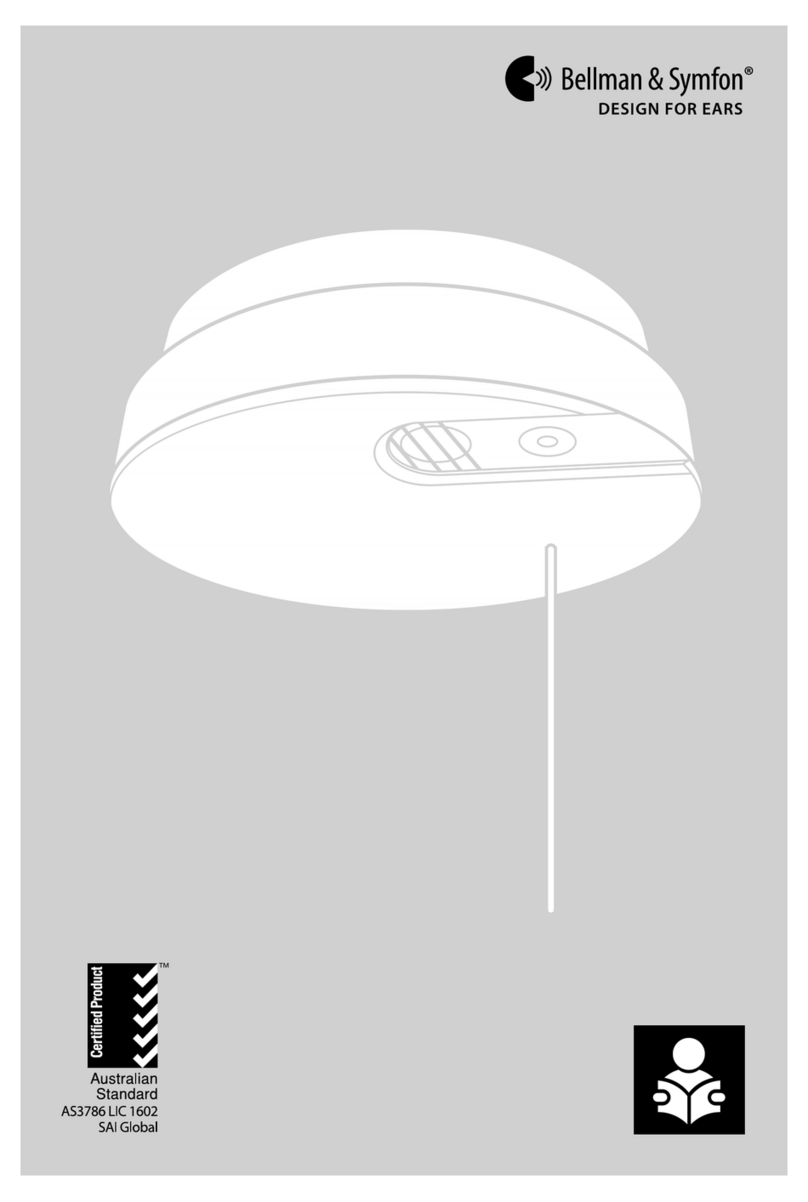
Bellman & Symfon
Bellman & Symfon BE1287 User manual
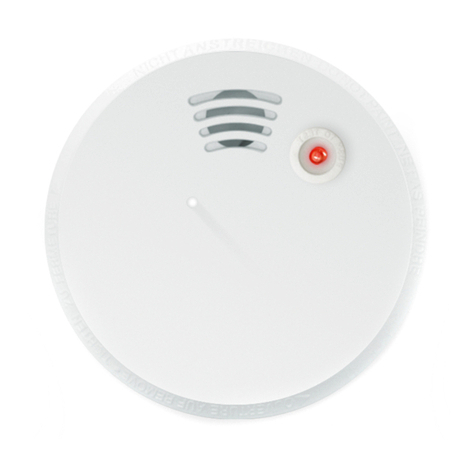
Bellman & Symfon
Bellman & Symfon BE1480 User manual
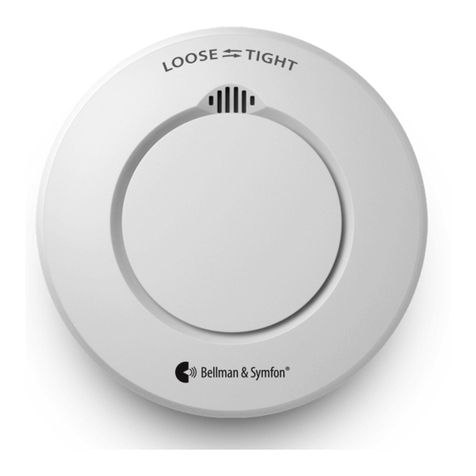
Bellman & Symfon
Bellman & Symfon BE1481 User manual
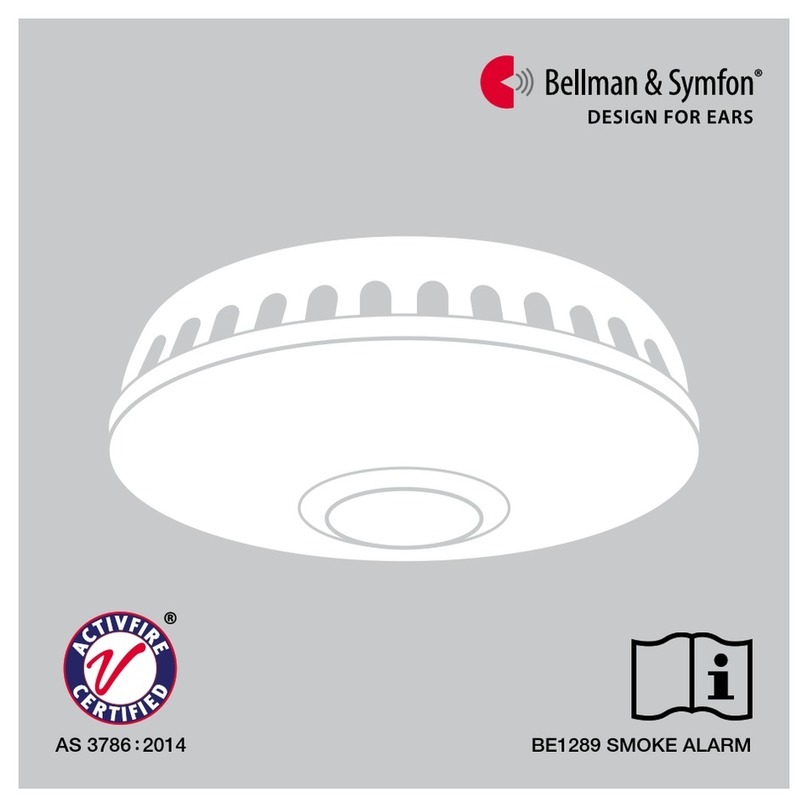
Bellman & Symfon
Bellman & Symfon BE1289 User manual
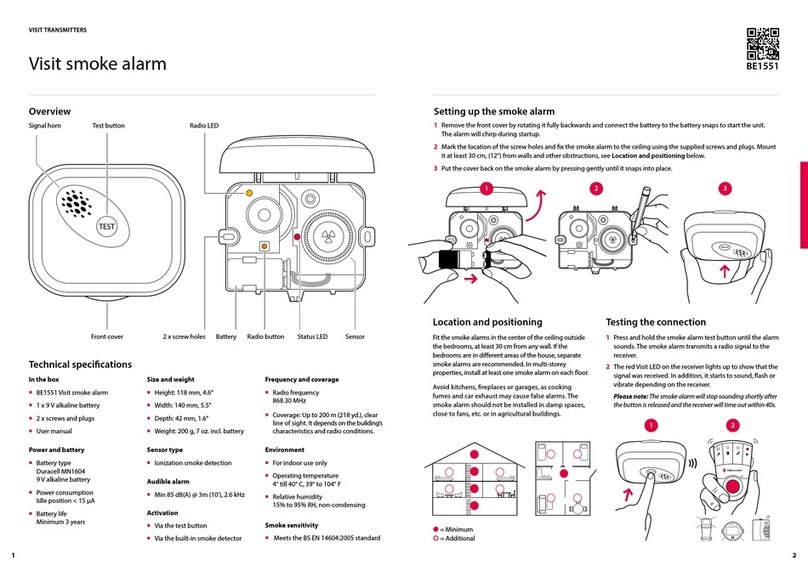
Bellman & Symfon
Bellman & Symfon VISIT BE1551 User manual
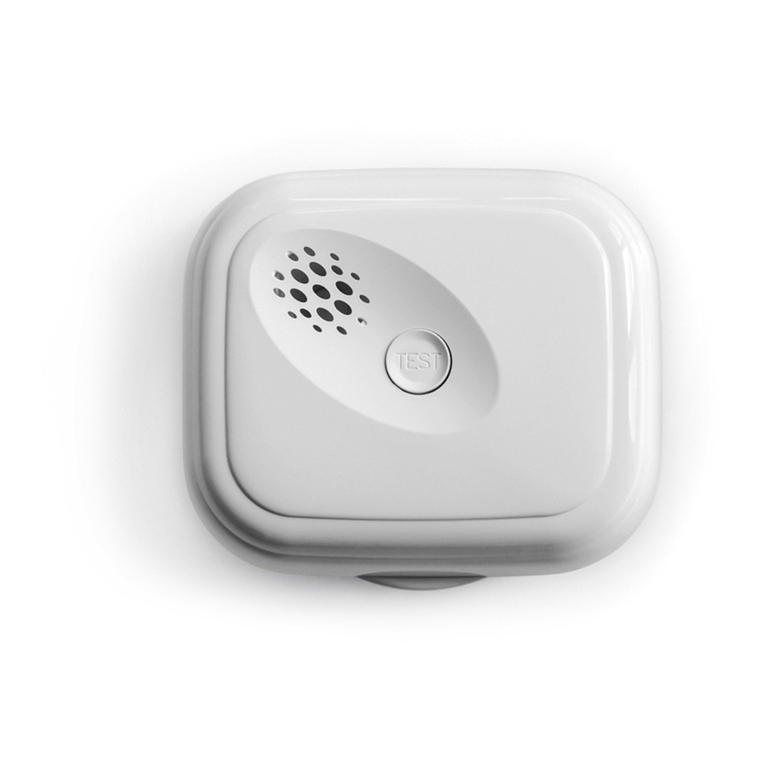
Bellman & Symfon
Bellman & Symfon VISIT BE1551 User manual
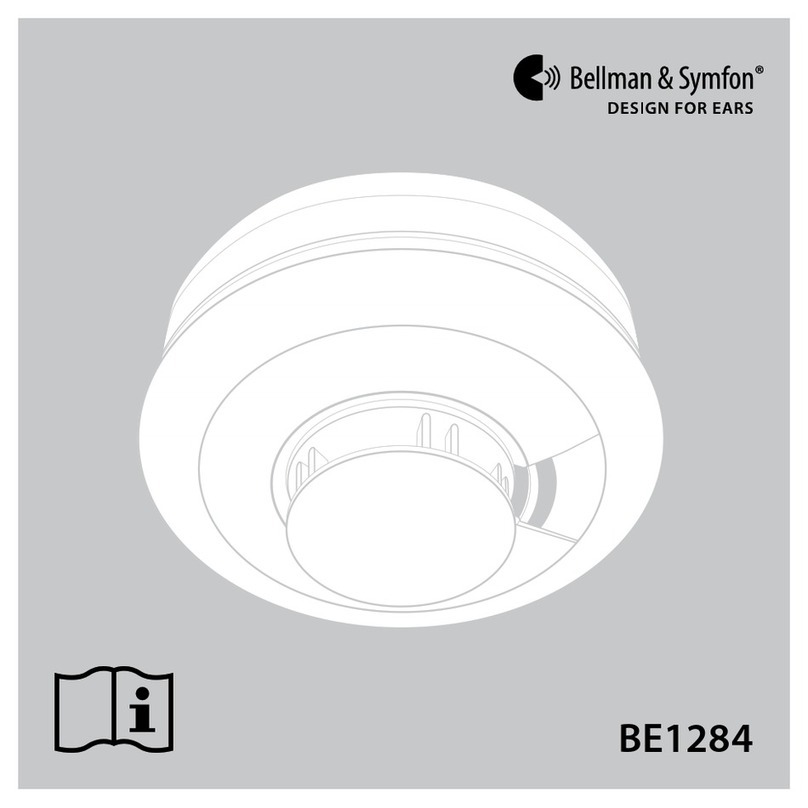
Bellman & Symfon
Bellman & Symfon BE1284 User manual
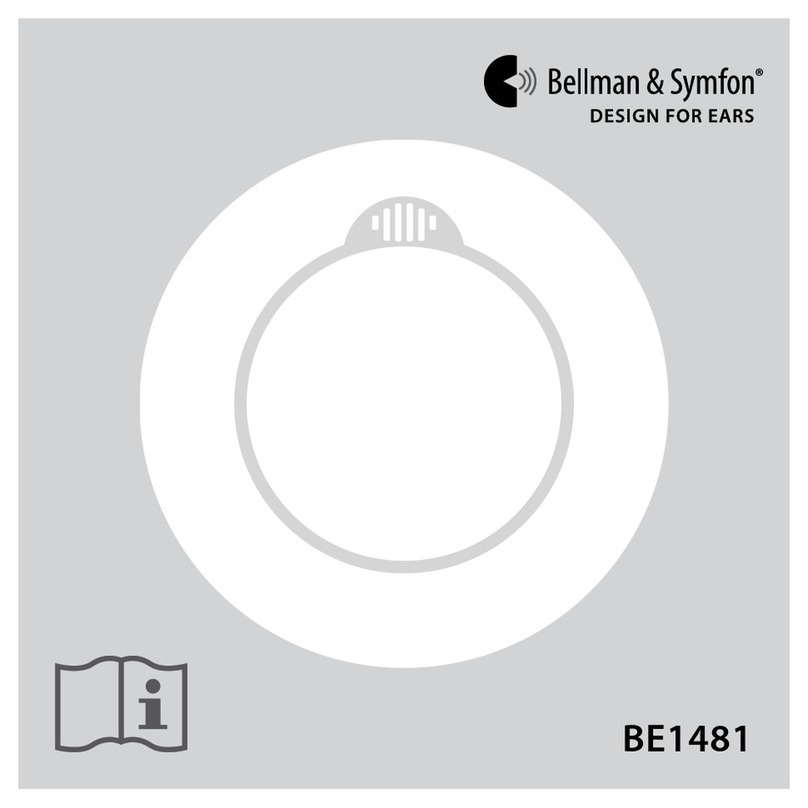
Bellman & Symfon
Bellman & Symfon BE1481 User manual

Bellman & Symfon
Bellman & Symfon BE1480 User manual
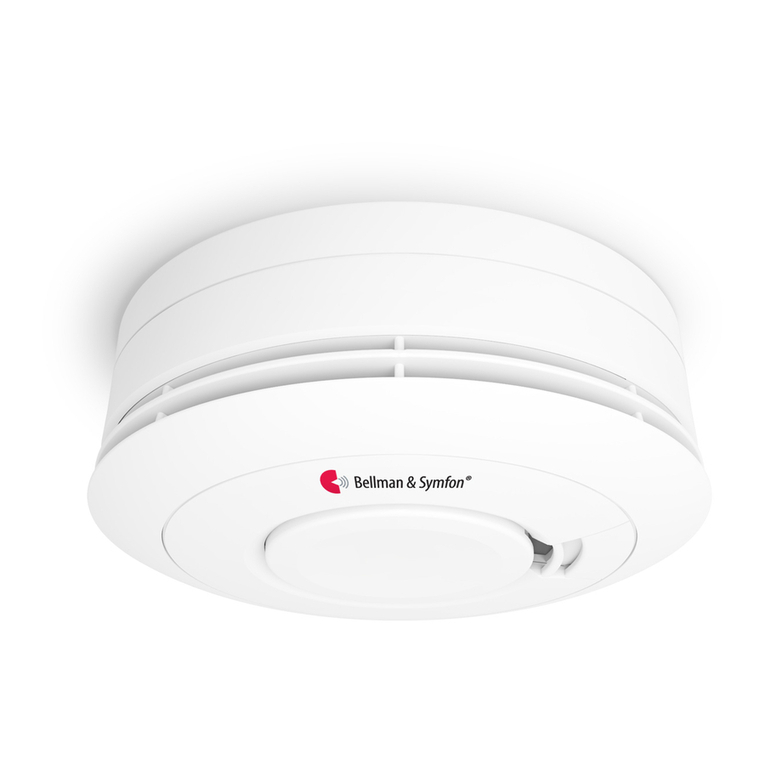
Bellman & Symfon
Bellman & Symfon BE1281 User manual

